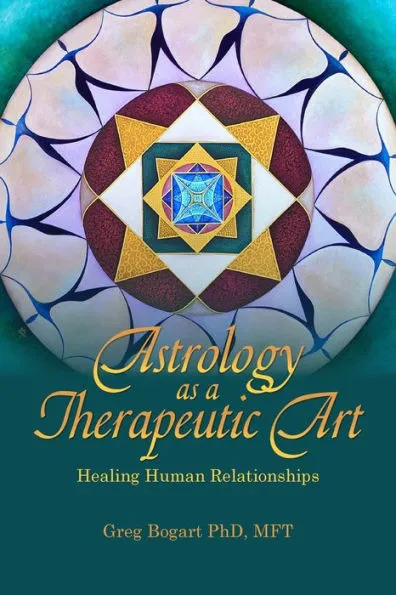Greg Bogart, Ph.D. MFT, is one of the astrology world’s most prolific exponents for integrating astrological counseling with professional psychotherapy. He calls what he does therapeutic astrology, and he’s written several previous books about it. In this new short volume, he gives examples of how he does this work because he wants to inspire others to work similarly to blend astrological and psychological counseling.
For those of us who rely on astrology as a healing modality, there’s an important distinction between astrologers-- even the most astute of them--who read a chart versus those like Bogart who base their work on dialoguing with a client about their chart. A therapeutic astrology session may zero in on a client’s current, specific problem or behavior, not necessarily their whole life course, or where they’re headed in the future. A natal chart, per se, is a static snapshot of a birth, a moment in time. But the practice of astrology, as Bogart writes, “is the study of our continuing evolution over time.” Each moment in someone’s life is “a meaningful phase of a larger cycle and cycles of development.”
Bogart works extensively with astrological transits, the symbolic meanings of the ever-changing planetary alignments in relation to a natal chart. His astrology is grounded in what I’ll call here more “secular” psychological theories of human development such as those of Erik Erikson. What distinguishes Bogart’s work is that he has in his mindset and in his communications toolkit the wealth of astrological knowledge than a non-astrological therapist simply lacks. Developmental psychologists can generalize with people about various ages and phases of growth. Every child, for example, goes through a version of the “terrible two’s.” That’s a child’s first Mars transit, when the planetary force of assertive independence returns to the sign and degree it was at upon birth. There are infinite variations of two-year-olds’ behavior. But it can be infinitely more helpful if a therapist understands the uniqueness of a child’s Mars function, by house, sign, natal and transiting aspects, let alone in synastry with the charts of primary care-givers.
The book consists largely of dozens of vignettes from Bogart’s counseling trove, mostly in the realm of relationships. (He has written elsewhere at length about his occupational therapy and about astrology vis. dream work and spirituality.) Each counseling story highlights a client who’s working with a common human dilemma, from anger management to recovering from divorce and bereavement, reconciling with estranged family members, you name it. Bogart works with some of the clients just once or twice, some ongoingly. He tells each story with the kind of knowledgeable care I imagine he brings to the counseling sessions.
What I love most about this book is that here—and pardon the old 1960s slogan—the medium is the message. Between Bogart’s commitment to bringing astrological wisdom to psychotherapy, and vice-versa, to the plethora of case studies he delightfully summarizes, his message is that there’s an abundance of good work to be done by combining the fields of astrology and psychotherapy.
He concludes that a therapeutic paradigm is useful for any astrologer oriented toward “emotional and psychological healing,” and especially for astrologers who “get trained in counseling skills and learn about effective facilitation.” He’s an advocate for astrology organizations that offer counseling skills training because, ultimately, “astrology can play an infinitely creative role in society, fostering the growth of centered, sane, and spiritually awakened individuals living harmoniously with others in an interdependent world.”
~review by Sara R. Diamond
Author: Greg Bogart
Wessex Astrologer, 2024
103 pp., $20.00

